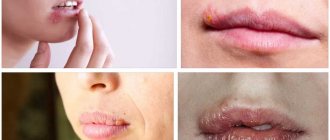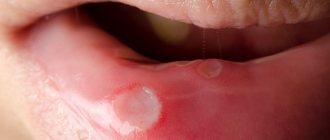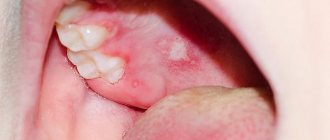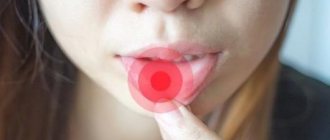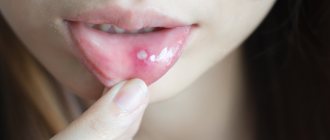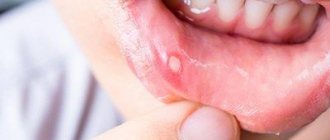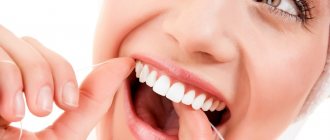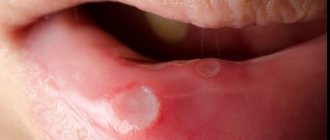Causes of herpes
Getting infected with herpes is easy. Kissing, sexual contact or using someone else's household appliances is enough. The virus can also be transmitted from mother to child through the placenta or during childbirth. As a rule, herpes does not appear immediately: a person may not know about its existence for years. However, under the influence of certain factors, herpes can awaken.
Causes of herpes on the gums:
- weakened immunity, colds;
- hypothermia;
- stress, overwork, lack of sleep;
- lack of hygiene;
- taking antibiotics;
- avitaminosis;
- teething;
- imbalance of microflora in the mouth.
Most often, herpes on the gums appears in the autumn-winter period, when the immune system is weakened and the body lacks vitamins.
Diagnosis and treatment of herpes infection
It is better to start treatment of herpes in the mouth at earlier stages of development to reduce the risk of complications and reduce the likelihood of infecting other people. In order to identify the disease, specialists carry out diagnostic measures:
- collect anamnesis;
- conduct an examination, determine the location of the rash and its nature;
- take a smear to identify the herpes virus and determine its type;
- laboratory tests are prescribed.
Modern methods for identifying the pathogen are a patient’s blood test to detect antibodies to the pathogen and a PCR study of tissues aimed at searching for the DNA of the viral particle. Differential diagnosis is of great importance, since herpetic infection must be distinguished from other similar diseases: stomatitis (not herpetic), tonsillitis, etc.
Herpes therapy is based on an integrated approach that combines:
- The use of local antiviral agents to stop the process of reproduction and spread of the pathogen;
- Prescribing antiviral medications for internal use (usually indicated for those whose symptoms occur frequently and acutely, or who are immunosuppressed);
- The use of antiseptic drugs for treating blisters and ulcers, rinsing;
- Use of topical anesthetic gels;
- Prescribing non-steroidal anti-inflammatory drugs to alleviate general well-being;
- Strengthening the immune system by taking vitamins and immunomodulators.
To eliminate symptoms, advanced technologies such as laser radiation are also used. The technique allows you to quickly and painlessly destroy viral particles without harming mucosal cells and effectively healing damaged tissue. In most cases, several short procedures are sufficient for complete disappearance of symptoms in 2-4 days.
How to understand that there is herpes on the gum
The main symptoms of herpes on the gums:
- The presence of “bubbles” filled with aqueous liquid.
- Redness and swelling at the site of the lesion.
- Itching and burning in the mouth.
Symptoms appear gradually: first there is pain and a burning sensation in the mouth, then the temperature rises, and the state of health worsens. Redness occurs, blisters appear, any touch of which causes pain. After a few days, the blisters burst, and in their place ulcers covered with a white coating form.
Herpes is often confused with canker sores because they have similar symptoms. Unlike stomatitis, herpes occurs in the same place where it was.
1.What is stomatitis, its types and symptoms
The term stomatitis refers to inflammatory processes in the oral cavity
that cause pain.
Stomatitis can cause discomfort and pain and interfere with eating, sleeping, and other daily activities. Canker sores can occur anywhere in the mouth, including the inside of the cheeks, gums, tongue, lips, and roof of the mouth
.
Types of stomatitis
There are several types of stomatitis, the main ones being:
- Ulcers
, also called aphthous ulcers. They usually appear in the mouth on the cheeks, tongue or lip, and appear as pale or yellowish sores with a red outer border; - Herpes
. Cold sores are fluid-filled sores that are located on or around the lips. Herpes on the gums and upper jaw also occurs, but very rarely. Herpes on the lips first looks like blisters filled with liquid, and then a crust or sore forms on it. Before a cold sore appears, there is often an itching, tingling or burning sensation on the lip. - Irritation of the oral mucosa
. It can be caused by biting the cheeks, tongue or lips, wearing braces, damage to the mucosa from a broken or sharp tooth, burns to the mouth from eating too hot food or liquids, gingivitis and other gum infections, and some autoimmune diseases. For example, systemic lupus, Crohn's disease or Behçet's disease. Mucosal irritation and stomatitis can be a side effect of treatment for other diseases - chemotherapy, antibiotics, drugs used to treat rheumatoid arthritis, epilepsy.
Symptoms of stomatitis
Symptoms of stomatitis depend on what type of stomatitis appears. So, mouth ulcer
usually painful and lasts 5 to 10 days. Often the ulcer appears again. And it is usually not associated with any colds.
Herpes
on the lip is not always painful. Rather, it causes discomfort. Herpes goes away in 7-10 days and its appearance is often a consequence of colds and flu.
A must read! Help with treatment and hospitalization!
How to treat herpes on the gums
For herpes on the gums, dentists prescribe antiviral drugs. They speed up healing and stop the active spread of herpes. The drugs have contraindications, so be sure to consult your dentist before purchasing.
During the treatment period, it is recommended to include more dairy products in your diet, avoid hot and cold foods - food should be warm and soft, because solid food can damage the affected mucous membrane. You should also drink more fluids.
Characteristic symptoms and diagnosis
Only type 1 herpes appears on the mucous membranes - this is the most common type of disease. With a sharp drop in immunity, fungal inflammation, candidiasis and other infections can join it.
This is what a fungal infection on the tongue looks like
“My husband recently developed herpes on his gum. Previously, of course, there were rashes, but always only on the lips, but here right in the mouth! The dentist prescribed antiviral medications and rinses for us. My husband says the sores cause a lot of trouble and make it impossible to eat normally. While we are being treated, it seems to be getting better, but to be honest, this turn of events came as a surprise to me. Before that, I didn’t even know that herpes can also appear on the oral mucosa.”
Maryam1992, Saratov, from correspondence on the woman.ru forum
The symptoms of the pathological condition largely depend on the form and extent of spread of the virus:
- the mild form involves the rather rapid maturation of watery blisters - in just a couple of days they burst and soon disappear without any outside help. In this case, the patient may experience only minimal discomfort, mainly during meals,
- the average form of pathology can provoke a jump in body temperature and cause general malaise. The blisters burst and form a cluster of ulcers, which during the healing process cause severe itching and burning, and inside the periodontium, and not in the gingival tissues,
- the severe form is accompanied by general intoxication of the body and often leads to the development of serious complications - erosive rashes affect not only the gums, but also the surface of the palate, the inside of the cheeks, lips and even the tonsils.
Herpes on the mucous membrane is a very unpleasant phenomenon.
High temperature and general loss of strength make the patient drowsy and disrupt appetite. In this case, the soft tissues of the oral cavity become red and swollen, which significantly complicates speech and the ability to chew food. The contents of the blisters contain large numbers of viral cells, which spread quickly when the blisters burst. Since this all happens in a moist environment, the healing process may take longer. As part of the diagnosis, the specialist needs to find out the specific type of pathogen, for which a smear is taken from the wound. This is necessary to choose the appropriate antiviral agent and treatment tactics in general.
What does traditional medicine offer?
The appearance of blisters on the mucous membrane prompts some people to try to eliminate the symptoms of the disease on their own. Of course, some of the traditional medicine recipes are indeed effective as maintenance therapy, but they will never replace full treatment. The following tips can be highlighted from proven “grandmother’s” methods:
- rinsing with herbal decoctions - antiseptic, anti-inflammatory and antimicrobial. These are chamomile, celandine, sage, wormwood and lemon balm. The dried herb should be poured with boiling water and left until it cools completely. Then the resulting substance should be filtered and used for rinsing after each meal,
- ginger, tea tree and sea buckthorn oils - used to treat affected areas of the mucous membrane so that the wounds heal faster,
- cranberry - not only prevents the further spread of infection, but also increases the overall resistance of the body. The berries need to be poured with boiling water and left alone for a while. The resulting product can be used not only for rinsing the mouth, but also for oral administration.
Gargling with medicinal herbs will help in treatment.
It should be understood that any pharmaceutical product or traditional medicine recipe can only be used with the consent of a specialist. Attempts to get rid of the problem on your own in most cases lead to a worsening of the situation, especially when it comes to treating a child.
Preventive measures after illness
To minimize the risks of infection and relapse of the disease, it is important to adhere to simple hygiene rules. In order to prevent the manifestation of the herpes virus, experts advise taking the following precautions:
- brush your teeth regularly and rinse your mouth after eating, wash your hands more often,
- try to exclude accidental damage to the oral mucosa,
- lead a healthy lifestyle and eat right,
- use exclusively personal hygiene products and do not lend them to strangers,
- minimize contact with carriers of infection,
- Visit the dentist at least twice a year for preventative care.
Everyone should have their own personal toothbrush.
Once the virus enters the body, it remains in it forever. It hides in the nerve cells of the brain, remaining in an inactive state. Unfortunately, it is impossible to get rid of the infection forever, but we can do everything to prevent the activation of viral cells.
- According to WHO.


